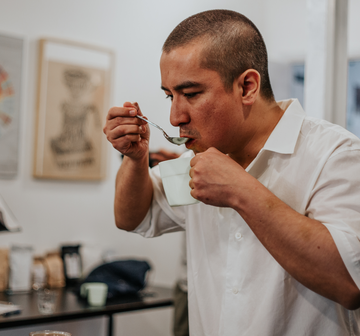Kenyan coffees are renowned for their unique fruit character, intense acidity, rich body and for producing a clean cup. Many factors contribute to these great qualities; the location of Kenya, the rare coffee varieties or the exceptional growing conditions.
Among these factors, processing is possibly the least looked at by consumers, but coffee farmers in this country continue to treat this important step with an incredible degree of precision and care.
The current process of double fermentation is used almost throughout the country and is considered best practice by most farmers.
THE PROCESS

FERMENTATION 1
In the double fermentation method, farmers pulp the cherries immediately after harvest and place the mucilage-coated seeds in fermentation tanks, with minimal contact with water, for 12 to 24 hours, depending on the speed of fermentation. .
Fermentation helps break down the mucilage making it easier to remove, but it also helps develop the dormant character of the mucilage fruit, imparting some of that character to the coffee bean.
In this first stage, fermentation is allowed to continue until a large part of the mucilage begins to separate from the seed.

WASH and RINSE
The coffee is washed from the tanks into water troughs where agitation helps rinse and remove loose mucilage, stopping the fermentation process. Seeds that are low-density "floaters" are also collected at this stage of the process, one of the many steps that ensure the consistently high quality of Kenyan coffee.
FERMENTATION 2
After cleaning the coffee, the first step is repeated, immersing it in a second fermentation tank for another 12 to 24 hours. This will restart the fermentation process, but this time with less sugar and fruit material available. At the end of this second stage, the coffee goes back through the water channels where any final mucilage residue is eliminated.
WASHED
Once the coffee has been separated, the different batches are transferred to their own water tanks where the coffees are soaked for an additional 24 hours. As the mucilage has been completely removed, and the coffee is steeping in much more water, it is assumed that the enzyme activity in the coffee increases in this steeping tank, resulting in a strengthening of the amino acids and proteins present in the coffees. .
DRYING AND CLASSIFICATION
The soaked seeds are scooped out and placed in elevated dryers and spread out to a depth of a couple of inches. The idea is to initially dry the coffee quickly to lower the moisture content and reduce risk. After this initial period of rapid drying, the coffee is mounded in 6-inch-deep mounds and moved to a longer, slower drying tract to promote long-term green quality stability. The time in the raised beds can vary greatly depending on the temperature and weather, but the coffee needs to be turned constantly during this period to achieve even drying. Once the coffee moisture reaches around 11-12%, this essentially concludes the processing of Kenyan coffee. Finally they are dry shelled, sorted and prepared for export.

PROS AND CONS
This double fermentation method provides us with a very clean cup with an extraordinary sweetness. On the contrary, it is intensive in manpower and natural resources. You must also be extremely careful in the process so as not to ruin the coffee due to over-fermentation.





